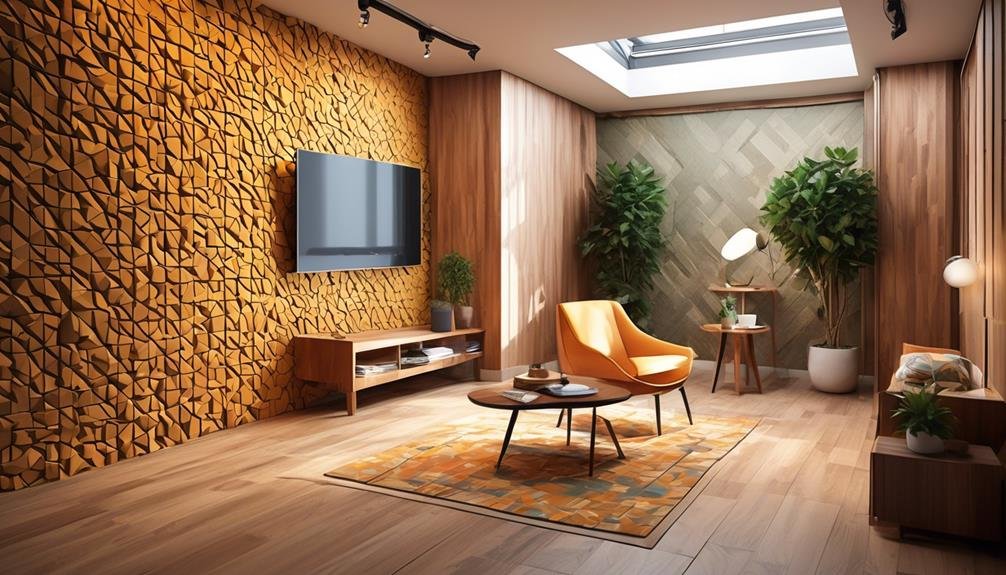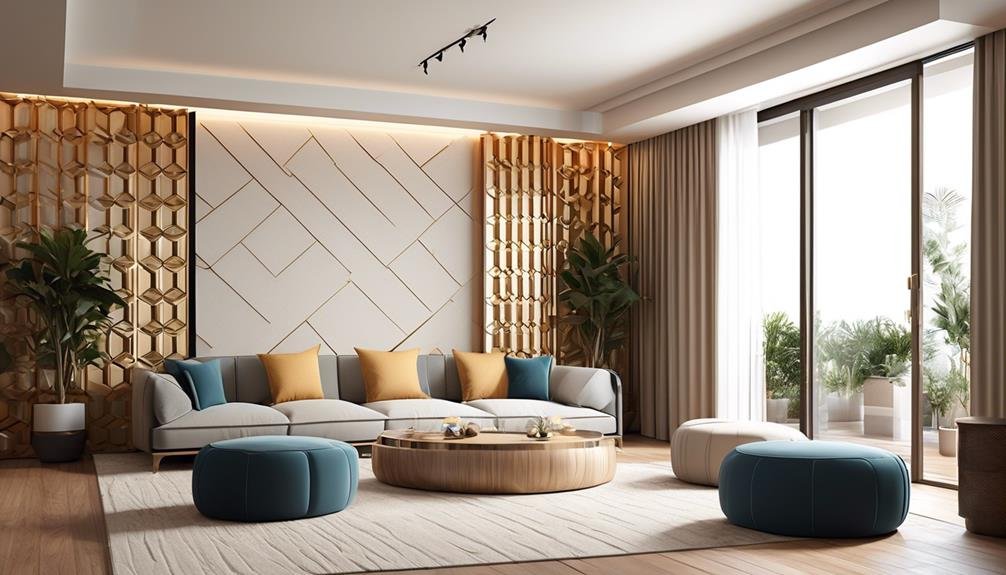Are you tired of the constant battle between your love for music and the need to keep the peace at home? Soundproofing doors and walls might just be the solution you've been seeking.
But where do you start? How can you ensure that your favorite tunes won't disturb the family?
In this discussion, we will explore effective techniques and materials that can help you create a more harmonious living environment.
So, let's dive into the world of soundproofing and discover the secrets to enjoying your music without causing any disruptions.
Key Takeaways
- Assessing sound leakage points is crucial in identifying areas that require soundproofing.
- Weatherstripping and door sweeps are effective in sealing gaps and reducing sound leakage from doors.
- Adding soundproofing materials such as Mass Loaded Vinyl, acoustic panels, and soundproof drywall can significantly improve sound insulation.
- Sealing gaps and cracks in walls and doors using high-quality caulk or sealant is essential for minimizing sound transmission.
Assessing the Sound Leakage Points
Are you wondering how to identify and locate the points where sound is leaking through your doors and walls? Assessing the sound leakage points is the first step in soundproofing your doors and walls effectively.
To begin, start by inspecting the door and wall surfaces for any visible gaps, cracks, or holes. These openings are major culprits for sound transmission and should be addressed immediately. Pay close attention to areas around windows, electrical outlets, and vents, as they're common weak points.
Next, you can conduct a simple sound test to identify additional leakage points. Close all doors and windows in the room and play music at a moderate volume. Walk around the perimeter of the walls and listen for any noticeable sound leakage. Areas where sound is more audible indicate potential weak spots and should be marked for further investigation. Additionally, you can use a sound meter to measure the sound levels at different points, comparing them to the desired soundproofing goals.
Furthermore, consider checking the door and wall seals. Inspect the weatherstripping on doors and windows for any signs of wear or damage. Replace any worn-out seals to ensure a tight seal and minimize sound leakage. Additionally, check the caulking and sealant around windows and door frames and make any necessary repairs.
Installing Weatherstripping and Door Sweeps
To effectively soundproof your doors and minimize sound leakage, you can begin by installing weatherstripping and door sweeps.
Weatherstripping is a material used to seal gaps around doors and windows, preventing drafts and reducing noise transmission. It comes in various forms, such as adhesive-backed foam tape, V-strip, and door gaskets.
Before installing weatherstripping, make sure to clean the surface and remove any existing adhesive residue or dirt. Measure the length needed and cut the weatherstripping accordingly. Apply it tightly along the sides and top of the door frame, ensuring a proper seal.
Door sweeps, on the other hand, are installed at the bottom of the door to block sound and prevent air drafts. They typically consist of a metal or plastic strip attached to a flexible rubber or brush seal.
Similar to weatherstripping, measure the width of the door and cut the door sweep accordingly. Attach it to the bottom of the door using screws or adhesive.
Adding Soundproofing Materials to Walls

You can effectively enhance the soundproofing of your walls by adding specialized materials. By incorporating these materials, you can significantly reduce the transmission of sound from one room to another, allowing you to enjoy your music without disturbing your family.
Here are three types of soundproofing materials that you can consider:
| Material | Description | Benefits |
| — | — | — |
| Mass Loaded Vinyl (MLV) | A dense, flexible material made of vinyl and other additives | – Excellent sound-blocking capabilities
- Easy to install
- Can be used on walls, ceilings, and floors |
| Acoustic Panels | Sound-absorbing panels made of foam, fabric, or other materials | – Absorbs sound waves, reducing echo and reverberation
- Improves the overall sound quality in the room
- Enhances the aesthetics of the space |
| Soundproof Drywall | A type of drywall with enhanced soundproofing properties | – Provides a higher level of sound insulation compared to regular drywall
- Easy to install and can be used as a replacement for existing drywall
- Can be painted or covered with wallpaper for a finished look |
Sealing Gaps and Cracks in Walls and Doors
To further enhance the soundproofing capabilities of your walls and doors, it's crucial to address and seal any gaps or cracks that may exist. These openings can allow sound to easily pass through, reducing the effectiveness of your soundproofing efforts.
Fortunately, sealing gaps and cracks is a relatively straightforward process that can significantly improve the sound insulation of your living space.
Start by thoroughly inspecting both your walls and doors for any visible gaps or cracks. Common areas to check include the edges of doors and windows, baseboards, electrical outlets, and any seams or joints in the walls. Once identified, use a high-quality caulk or sealant to fill in these gaps. Opt for a product that's specifically designed for soundproofing, as it will provide better results.
When applying the caulk or sealant, ensure that you create a tight seal that completely fills the gaps. Use a caulk gun for precise application and smooth the surface with a putty knife for a clean finish. Be sure to follow the manufacturer's instructions for the best results.
In addition to sealing gaps, it's also important to address any cracks in your walls or doors. Small cracks can easily allow sound to pass through, so it's essential to fill them in. Use a spackling compound or patching plaster to repair these cracks. Apply the compound or plaster with a putty knife, following the manufacturer's instructions for the appropriate drying time.
Using Acoustic Panels and Curtains

Acoustic panels and curtains offer effective solutions for enhancing soundproofing in your living space. These specialized products can significantly reduce the amount of noise that escapes through doors and walls, providing a quieter environment for both you and your family.
Here are some reasons why acoustic panels and curtains are a great investment:
- Improved sound absorption: Acoustic panels are designed to absorb sound waves, preventing them from bouncing off hard surfaces and causing echoes or reverberations. This helps to reduce noise transmission and improve the overall acoustics of the room.
- Easy installation: Acoustic panels and curtains are typically lightweight and easy to install. They can be mounted on walls or hung from ceilings, allowing for flexible placement options. Some panels even come with adhesive backing for hassle-free installation.
- Aesthetically pleasing: Acoustic panels and curtains come in a variety of colors, shapes, and sizes, allowing you to choose options that complement your existing decor. They can be seamlessly integrated into your living space without compromising its visual appeal.
- Versatile functionality: Acoustic panels and curtains aren't only effective for soundproofing music rooms or home theaters but also for reducing noise from outside sources such as traffic or neighbors. They offer a versatile solution to address various noise-related issues in your home.
Frequently Asked Questions
How Much Does It Cost to Soundproof a Door or Wall?
Soundproofing a door or wall can vary in cost depending on factors such as materials used and size of the area. It's best to consult with professionals who can provide accurate estimates specific to your needs.
Can I Soundproof a Door Without Removing It?
To soundproof a door without removing it, you can use weatherstripping to seal gaps and install a door sweep to block sound. Adding a soundproofing curtain or panel can also help reduce noise transfer.
What Are the Best Soundproofing Materials for Walls?
To soundproof walls effectively, you need materials with high density and mass to absorb and block sound. Options include mass-loaded vinyl, acoustic foam panels, and fiberglass insulation. Research and choose the best suited for your needs.
Can I Use Regular Curtains Instead of Acoustic Curtains?
Regular curtains are not as effective as acoustic curtains for soundproofing. Acoustic curtains are designed with special materials to absorb and block sound waves, providing better insulation.
Will Soundproofing a Door or Wall Completely Eliminate All Noise?
Soundproofing a door or wall will significantly reduce noise, but it may not eliminate all sound completely. To achieve maximum effectiveness, use materials like acoustic curtains, weatherstripping, and soundproof foam panels.
Conclusion
In conclusion, soundproofing doors and walls is an effective solution to prevent music from disturbing your family.
By assessing the sound leakage points, installing weatherstripping and door sweeps, adding soundproofing materials to walls, sealing gaps and cracks, and using acoustic panels and curtains, you can create a quieter environment.
These methods will help minimize sound transmission and ensure a more peaceful living space for everyone in the household.





